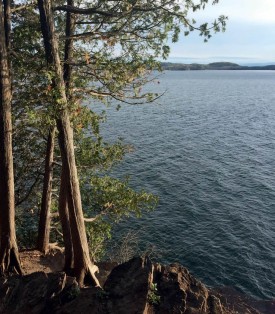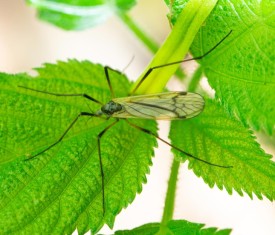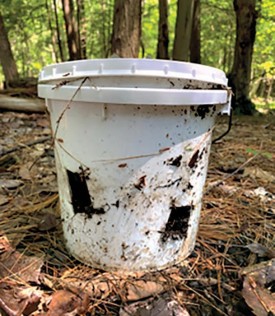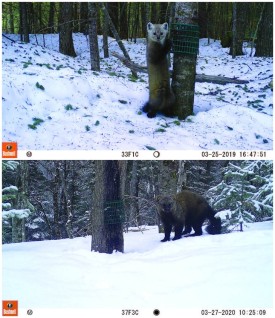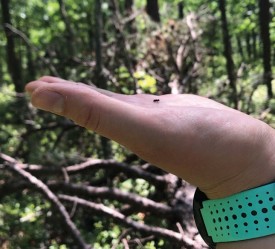In 1900, much of the forest in the eastern United States was filled with oaks and other trees that tolerated fire. This structure in part reflected previous centuries of shaping by Indigenous…
Discoveries
The Sound of Oaks
The oaks are not doing well at Black Rock Forest. Their growth has slowed as new species of trees have found their way into the woods, and pathogens (such as the fungus that causes oak wilt),…
A Stormy Future for Carbon Offsets
Carbon offset programs often withhold 10 to 20 percent of offsets generated by a project, as a buffer against changes to the forest that might affect carbon storage over a century or more. But…
The Importance of Snow to the Bluff Forests of Lake Champlain
Red Rocks Park in South Burlington, Vermont, takes its name from the iron-tinged Monkton Quartzite, formed some 500 million years ago. But above the old red sandstone are bands of younger…
Landowner Preferences and Motivations for Controlling Invasive Plants
Invasive plants impact the ecological integrity and timber production potential of forests. One particularly problematic species is glossy buckthorn (Frangula alnus). A shade-tolerant,…
Land Protection and Taxes?
Land protection has increased in recent decades parallel with development pressures. Town leaders struggling to balance budgets and to provide services often resist conservation because of…
Genetic Diversity of Moose in the Northeast
The northeastern population of moose, subspecies Alces alces americana, declined during the nineteenth century as a result of hunting and forest clearing for agriculture. Hunting regulation…
Characterizing Community Forests
What we in the Northeast sometimes call a “Town Forest” is known elsewhere as a “Community Forest.” Although common and cherished by local residents, these publicly…
Changing Winter Means Hard Future for Northern Hardwoods
Moisture is a major factor encouraging the growth of northern hardwood trees, but timing is just as important as volume. New research from University of Vermont and the U.S. Forest Service has…
What Do Bats Eat, Anyway?
Northeastern bats are on the decline for multiple reasons, especially fungal pathogens that cause white-nose syndrome. To support bat conservation efforts, researchers at University of New…
A Biome Shift in Earth’s Coldest Forests
The boreal forest encircles the northern hemisphere from Alaska to Russia to Scandinavia to Labrador, making up almost one-quarter of global forest area and containing more than a third of…
Forests and Lakes Remember Acid Rain. Do You?
For decades, acid rain was one of the biggest problems affecting northern forests, the focus of extensive research and advocacy in the latter decades of the twentieth century. The fact that…
A New Threat to Northeastern Salamanders
First identified in 1998, the chytrid fungus Batrachochytrium dendrobatidis has infected more than 1,300 amphibian species in the last decade and led to the population decline of more than 200…
Rare Plants Hold Their Own on Adirondack Mountain Summits
Alpine plants grow where they do because mountain summits are cold, icy, windy, snowy – but also sunlit, dry, and hot. Alpine plants are directly vulnerable to warming temperatures, and…
Winter May Not Be the Limit for Blacklegged Ticks
For as long as the blacklegged tick has been expanding its range in the Northeast, many have thought that cold winters limit its geographic range. This belief in part derived from laboratory…
Marten and Fisher Can and Do Coexist in the Maine Woods
The American marten (Martes americana) and fisher (Pekania pennanti) are closely related inhabitants of the Northern Forest region. Both species have been impacted by historical trapping and…
Impact of Covid-19 on Recreation in New England
Two and a half years ago, much of the world shut down in response to the emergence of the Covid-19 virus. Some people worked, many stayed home, everyone worried. The outdoors was both the…
Southern Pine Beetle Found in Maine and New Hampshire
Up until a few decades ago, cold temperatures limited the range of the southern pine beetle to areas south of New Jersey, where winter temperatures rarely dip below minus 15 degrees…
Study Sheds New Light on Forest Edges
Forest fragments in tropical regions are often skirted by trees dying along the edges as the ecosystem declines. But new research in northeastern forests suggests that a different dynamic is…
Foldable, Moldable Wood
The modern world is filled with plastic in part because plastic is, well, plastic: flexible and moldable, polymers can be formed into a seemingly infinite variety of shapes. Aluminum, too, has…





